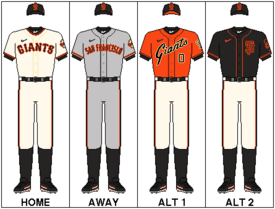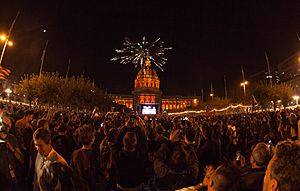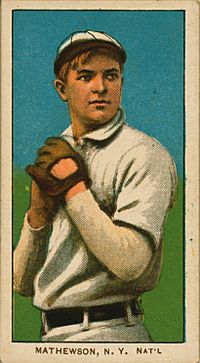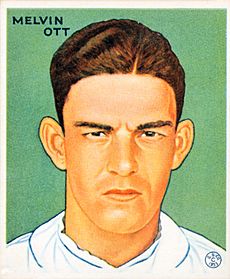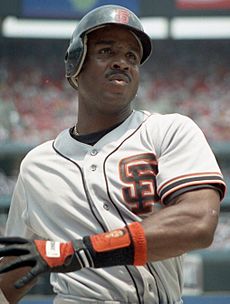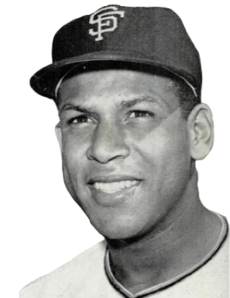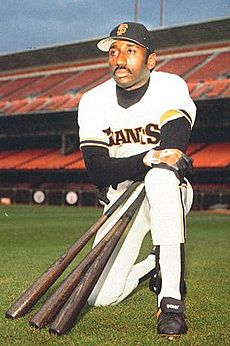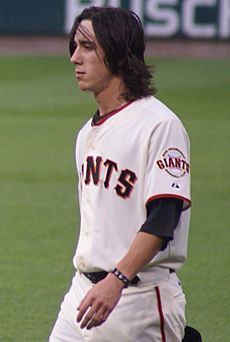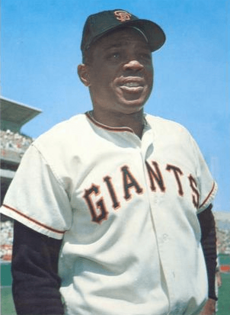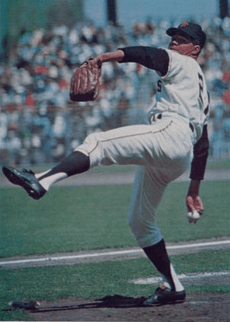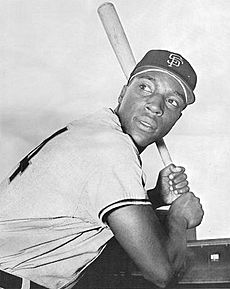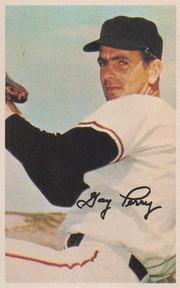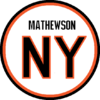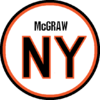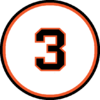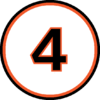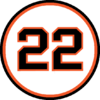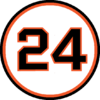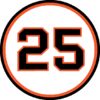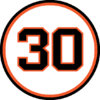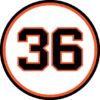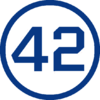San Francisco Giants facts for kids
Quick facts for kids San Francisco Giants |
|||||
|---|---|---|---|---|---|
|
|||||
|
|||||
| Major league affiliations | |||||
|
|||||
| Current uniform | |||||
| Retired numbers | |||||
| Colors | |||||
|
|||||
| Name | |||||
|
|||||
| Other nicknames | |||||
|
|||||
| Ballpark | |||||
|
|||||
| Major league titles | |||||
| World Series titles (8) |
|
||||
| NL Pennants (23) |
|
||||
| West Division titles (9) |
|
||||
| Temple Cup (1) |
|
||||
| Pre-modern World Series (2) |
|
||||
| Wild card berths (3) |
|
||||
| Front office | |||||
| Principal owner(s) | Charles B. Johnson Greg E. Johnson (Chairman) |
||||
| President | Larry Baer | ||||
| President of baseball operations | Buster Posey | ||||
| General manager | Zack Minasian | ||||
| Manager | Bob Melvin | ||||
The San Francisco Giants are a professional baseball team located in San Francisco. They play in Major League Baseball (MLB) as part of the National League (NL) West Division. The team started in 1883 as the New York Gothams. Three years later, they became the New York Giants. In 1958, the team moved from New York City to San Francisco. Today, the Giants play their home games at Oracle Park in San Francisco.
The Giants are one of the oldest and most successful teams in baseball history. They have won more games than any other team in major American sports. The team was the first major league baseball organization in New York City. They famously played many home games at different versions of the Polo Grounds. The Giants have played in the World Series 20 times. In 2014, they won their 23rd National League pennant. This record was later matched and then passed by their rivals, the Los Angeles Dodgers, who won their 25th NL title in 2024. The Giants have won eight World Series championships, which ties them for second-most in the NL with the Dodgers. They are tied for the fifth-most championships among all baseball teams.
While in New York, the team won 17 pennants and five World Series championships. Famous managers like John McGraw, Bill Terry, and Leo Durocher led the team. Star players from the New York era, including Christy Mathewson, Carl Hubbell, Mel Ott, and Willie Mays, are among the 64 Giants in the Baseball Hall of Fame. This is more than any other team. The Giants' rivalry with the Dodgers is one of the oldest and most famous in American sports. It began in New York and continued when both teams moved to California in 1958.
After moving west, the Giants faced a long 56-year period without winning a championship. This time included three World Series losses, even with great players like Mays and Barry Bonds. The championship drought finally ended in the early 2010s. Under manager Bruce Bochy, the Giants used new strategies and became a baseball dynasty. They won the World Series in 2010, 2012, and 2014. This made the Giants the second team in NL history to win three championships in five years.
As of the end of the 2024 season, the Giants' overall record is 11,541 wins, 10,019 losses, and 163 ties. This means they have won about 53.5% of their games. Since moving to San Francisco in 1958, their record is 5,474 wins, 5,121 losses, and 6 ties, winning about 51.7% of their games. The team's current manager is Bob Melvin.
Contents
Team History and Milestones
Early Years in New York City
The Giants started in New York City as the New York Gothams in 1883. They were known as the New York Giants from 1885 until they moved to San Francisco after the 1957 season. For most of their 75 years in New York, the Giants played home games at different versions of the Polo Grounds in Upper Manhattan.
Many famous players who are now in the National Baseball Hall of Fame and Museum played for the New York Giants. These include John McGraw, Christy Mathewson, Mel Ott, Bill Terry, Willie Mays, Monte Irvin, and Travis Jackson. While in New York, the team won five of its eight World Series titles (in 1905, 1921, 1922, 1933, and 1954). They also won 17 of their 23 National League pennants.
Famous moments from the Giants' time in New York include the 1922 World Series. In that series, the Giants beat the Yankees in four games. Another famous moment was the 1951 home run by Bobby Thomson, known as the "Shot Heard 'Round the World". Also, Willie Mays made an amazing defensive play in Game 1 of the 1954 World Series, called "the Catch".
The Giants had strong rivalries with other New York teams, the New York Yankees and the Brooklyn Dodgers. The Giants played the Yankees in six World Series. They also played the Dodgers many times each season. Games between any two of these three teams were called the Subway Series. The Dodgers-Giants rivalry is still strong today because both teams moved to California after the 1957 season. The Dodgers moved to Los Angeles. The New York Giants football team in the National Football League (NFL) is named after the baseball team.
Moving to San Francisco
The Giants and their rivals, the Los Angeles Dodgers, were the first Major League Baseball teams to play on the West Coast. On April 15, 1958, the Giants played their first game in San Francisco. They beat the Dodgers, who had also just moved from Brooklyn to Los Angeles, by a score of 8–0.
The Giants played for two seasons at Seals Stadium (which was home to the PCL's San Francisco Seals from 1931 to 1957). Then, in 1960, they moved to Candlestick Park. The Giants played at Candlestick Park until 1999. In 2000, they opened Pacific Bell Park (now known as Oracle Park), where they play today.
The Giants faced challenges in their first 50 years in San Francisco. They made it to the playoffs nine times and won three NL pennants between 1958 and 2009. The Giants lost the 1962 World Series in seven games to the New York Yankees. They were also swept in the 1989 World Series by their cross-Bay rivals, the Oakland Athletics. This series is famous for the 1989 Loma Prieta earthquake, which caused a 10-day delay between Games 2 and 3. The Giants also lost the 2002 World Series to the Anaheim Angels.
One of the team's biggest highlights during this time was the 2001 season. In that year, outfielder Barry Bonds hit 73 home runs, breaking the record for most home runs in a single season. In 2007, Bonds also passed Hank Aaron's career record of 755 home runs. Bonds finished his career with 762 home runs (586 of which he hit with the Giants), which is still the MLB record.
The Giants won three World Series championships in 2010, 2012, and 2014. This gave the team eight total World Series titles, including the five they won as the New York Giants.
Players who were inducted into the National Baseball Hall of Fame and Museum as members of the San Francisco Giants include Willie Mays, Orlando Cepeda, Juan Marichal, Willie McCovey, and Gaylord Perry.
Team Uniforms and Style
Uniform Changes Over the Years
When the Giants moved to San Francisco, they kept their New York uniform style. The cap logo changed to an interlocking "SF" in orange. The road uniform now said "San Francisco" in black letters with orange trim.
In 1973, the uniforms changed to a double-knit polyester fabric. The letters became orange with black trim, and player names were added to the back. The cap logo stayed the same.
For the 1977 season, the Giants switched to pullover uniforms. The "Giants" on the home uniform changed to a cursive script. The colors returned to black with orange trim. The road uniform became orange with black and white letters.
In 1983, the Giants went back to a traditional buttoned uniform. This design looked more like their early San Francisco uniforms. The letters became more rounded, and the caps were all black.
In 1994, the road uniform went back to saying "San Francisco" on the front. The letters on both uniforms became a stylized block shape with pointed edges.
Current Uniforms (2000–Present)
When the Giants moved to Oracle Park in 2000, they introduced new uniforms. These uniforms looked similar to the ones they wore in their early years.
Home Uniform
The home uniform changed to a cream color. The "Giants" wordmark kept its stylized block letters, but it was arranged in a radial arch. Gold drop shadows were added, and neck stripes returned. A sleeve patch with the team logo and "San Francisco Baseball Club" was also added.
Road Uniform
The gray road uniform brought back the classic "San Francisco" wordmark from the 1960s. In 2005, gold drop shadows were added. In 2012, black piping was added to this uniform. Until 2020, only the road uniform had player names on the back. Since 2021, all Giants uniforms have player names.
Black Alternate Uniforms
In 2001, the Giants added black alternate uniforms for both home and road games. The home black uniform was used for only one season. The road black uniform was retired the following year.
In 2015, the Giants introduced a new black alternate uniform for some Saturday home games. This uniform has the interlocking "SF" on the front with orange piping. It also has a new sleeve patch showing the Golden Gate Bridge above the "Giants" wordmark. Since 2025, this uniform is also worn for some road games.
Orange Alternate Uniforms
Before the 2010 season, the Giants added a new orange alternate uniform for Friday home games. This uniform is usually worn with a black cap that has an orange brim and the "SF" logo.
City Connect Uniforms
In 2021, Major League Baseball and Nike started the "City Connect" program. Teams wear special uniforms that show the unique spirit of their community. The Giants' first City Connect uniform was white with orange accents. It featured a stylized "G" with an orange and white fade, representing the San Francisco fog. An orange outline of the Golden Gate Bridge was on the sleeves. These uniforms were usually worn on Tuesday home games.
In 2025, the Giants introduced their new City Connect 2.0 uniforms. These jerseys are dark gray/black with "Giants" in a script wordmark that has a purple and orange fade. The sleeves have a special glove design that says "San Francisco Giants Est 1958" in a style similar to 1960s San Francisco rock music posters. The jersey also has wave patterns, called "sound waves," that look like grooves on a vinyl record. The front jersey numbers are orange in a fun font. The hat has the "SF" in the same font with a faded brim. The pants are white with faded piping.
Team Rivalries
Giants vs. Dodgers: A Long-Standing Rivalry
The rivalry between the Giants and the Los Angeles Dodgers is one of the longest in sports history. It began in the late 1800s when both teams were in New York City. The Dodgers were in Brooklyn, and the Giants played in Manhattan.
After the 1957 season, the Dodgers' owner, Walter O'Malley, decided to move his team to Los Angeles for financial reasons. He convinced the Giants' owner, Horace Stoneham, to move his team to San Francisco. This kept their rivalry alive on the West Coast. New York baseball fans were very sad about the move. Since Los Angeles and San Francisco have always been rivals in many ways, their new locations were perfect for continuing this old baseball rivalry. After the Giants and Dodgers left New York, a new team, the New York Mets, was formed in 1962. The Mets' colors (blue and orange) were a tribute to the two teams that had left.
This rivalry is considered one of the greatest in sports history because both teams have lasted over a century and moved across the country. The rivalry grew from being between two city teams to two state teams.
Both teams have had periods of success against each other. The Giants have more total wins and head-to-head wins in their overall history. However, the Dodgers have more total wins and head-to-head wins since both teams moved to California in 1958. The Dodgers have also won the National League West division 14 more times than the Giants since division play started in 1969. Both teams have made the postseason as a National League wild card three times. The Giants won their first World Series in California in 2010. The Dodgers won their most recent World Series in 2024. As of the end of the 2024 baseball season, the Los Angeles Dodgers lead the San Francisco Giants in California World Series wins, 7–3. In 20th-century New York, the Giants led the Dodgers in World Series championships, 5–1. Overall, the two teams are tied with 8 World Series championships each.
Giants vs. Athletics: The Bay Bridge Series
The Giants also have a local rivalry with the American League Athletics, who play across the Bay in Oakland. This rivalry grew a lot with the 1989 World Series, which was called the "Battle of the Bay." Oakland won that series, which was famously stopped by the 1989 Loma Prieta earthquake just before Game 3 in San Francisco.
This rivalry actually goes back to when the Giants were in New York and the Athletics were in Philadelphia. They played each other in the World Series in 1905, 1911, and 1913. The rivalry was renewed in 1968 when the Athletics moved from Kansas City to Oakland. Since 1997, when interleague play began, the two teams usually play each other six times every season.
The Giants and A's had a smaller rivalry at the start of the 1900s. This was before the Yankees became dominant after getting Babe Ruth in 1920. The teams were managed by legendary leaders John McGraw (Giants) and Connie Mack (Athletics). They were considered friendly rivals and top managers of that time. As the New York Giants and Philadelphia A's, they met in three World Series. The Giants won in 1905, and the A's won in 1911 and 1913. After becoming the San Francisco Giants and Oakland A's, they met in a fourth World Series in 1989. This was the A's last World Series championship as of 2024.
Giants vs. Yankees: An Old New York Rivalry
Even though they are in different leagues, the Giants and Yankees have also been historical rivals. This rivalry started in New York before the Giants moved to the West Coast. Before interleague play began in 1997, the two teams rarely played each other. They only met in seven World Series: in 1921, 1922, 1923, 1936, 1937, 1951, and 1962. The Yankees won five of these seven series.
The teams have played five times in regular season interleague games. These games happened in 2002, 2007, 2013, 2016, 2019, and 2023. With the new balanced schedule format introduced in 2023, the teams now play each other every year.
In his famous farewell speech on July 4, 1939, Yankees slugger Lou Gehrig said that the Giants were a team he "would give his right arm to beat, and vice versa."
Baseball Hall of Fame Members
As of 2024, the Major League Baseball Hall of Fame has inducted 66 people who represent the Giants. This includes 55 players and 11 managers. This is more than any other team in baseball history.
| San Francisco Giants Hall of Famers | ||||||||||||||||||
|---|---|---|---|---|---|---|---|---|---|---|---|---|---|---|---|---|---|---|
| Affiliation according to the National Baseball Hall of Fame and Museum | ||||||||||||||||||
|
Ford C. Frick Award Winners
| San Francisco Giants Ford C. Frick Award recipients | |||||||||
|---|---|---|---|---|---|---|---|---|---|
| Affiliation according to the National Baseball Hall of Fame and Museum | |||||||||
|
Other Honored Individuals
Some Hall of Fame members played or managed for the Giants but were inducted for their work with other teams. For example, Cap Anson managed the Giants in 1898 but was inducted as a player. Frank Robinson managed the Giants from 1981 to 1984 but was inducted as a player.
Broadcasters Russ Hodges, Lon Simmons, and Jon Miller are honored in the Hall's "Scribes & Mikemen" exhibit. They won the Ford C. Frick Award for their broadcasting work.
Bay Area Sports Hall of Fame Members
| Giants in the Bay Area Sports Hall of Fame | ||||
| No. | Name | Position | Tenure | Notes |
|---|---|---|---|---|
| — | Bob Lurie | Owner | 1976–1993 | Born in San Francisco |
| — | Peter Magowan | Owner/President | 1993–2008 | Attended Stanford University |
| 1, 18 | Bill Rigney | IF Manager |
1946–1953 1956–1960, 1976 |
Born and raised in Alameda |
| 2 | Dick Bartell | SS | 1935–1938 1941–1943, 1946 |
Grew up in Alameda |
| 4 | Ernie Lombardi | C | 1943–1947 | Elected mainly on his performance with Cincinnati Reds, grew up in Oakland |
| 6 | Tony Lazzeri | 2B | 1939 | Elected mainly on his performance with New York Yankees, born and raised in San Francisco |
| 8 | Joe Morgan | 2B | 1981–1982 | Elected mainly on his performance with Cincinnati Reds, raised in Oakland |
| 9, 10, 60 | Matt Williams | 3B | 1987–1996 | |
| 12 | Dusty Baker | OF Manager |
1984 1993–2002 |
|
| 14 | Vida Blue | P | 1978–1981 1985–1986 |
Elected mainly on his performance with Oakland A's |
| 15 | Bruce Bochy | Manager | 2007–2019 | Managed 2010, 2012, 2014 World Series winners |
| 16 | Lefty O'Doul | LF | 1928 1933–1934 |
Born in San Francisco |
| 18, 43 | Matt Cain | P | 2005–2017 | Pitched a perfect game in 2012 |
| 19, 33 | Dave Righetti | P Coach |
1991–1993 2000–2017 |
Born and raised in San Jose |
| 20 | Frank Robinson | Manager | 1981–1984 | Elected mainly on his performance with Cincinnati Reds and Baltimore Orioles |
| 21 | Jeff Kent | 2B | 1997–2002 | Attended UC Berkeley |
| 22 | Will Clark | 1B | 1986–1993 | |
| 24 | Willie Mays | CF | 1951–1952 1954–1972 |
|
| 25 | Barry Bonds | LF | 1993–2007 | Grew up in San Carlos |
| 27 | Juan Marichal | P | 1960–1973 | |
| 30 | Orlando Cepeda | 1B | 1958–1966 | |
| 36 | Gaylord Perry | P | 1962–1971 | |
| 43 | Dave Dravecky | P | 1987–1989 | |
| 44 | Willie McCovey | 1B | 1959–1973 1977–1980 |
|
Giants Wall of Fame
The Giants Wall of Fame honors retired players who have achieved great things and played for the San Francisco Giants for a long time.
To be honored, players must have played at least nine seasons for the San Francisco Giants. Or, they must have played five seasons with at least one All-Star selection as a Giant. Another way is to have won three World Series championships as a Giant.
| Year | Year inducted |
|---|---|
| Bold | Member of the Baseball Hall of Fame |
|
|
Member of the Baseball Hall of Fame as a Giant |
| San Francisco Giants Wall of Fame | ||||
| Year | No. | Name | Position(s) | Tenure |
|---|---|---|---|---|
| 2008 | 23, 49 | Felipe Alou | OF/1B Manager |
1958–1963 2003–2006 |
| 46 | Gary Lavelle | P | 1974–1984 | |
| 33 | Jim Barr | P | 1971–1978 1982–1983 |
|
| 10 | Johnnie LeMaster | SS | 1975–1985 | |
| 14, 24 | Willie Mays |
CF | 1951–1952, 1954–1972 | |
| 47 | Rod Beck | P | 1991–1997 | |
| 00, 20, 26 | Jeffrey Leonard | LF | 1981–1988 | |
| 14 | Vida Blue | P | 1978–1981 1985–1986 |
|
| 8, 17, 19 | Kirt Manwaring | C | 1987–1996 | |
| 44 | Willie McCovey |
1B | 1959–1973 1977–1980 |
|
| 42 | Bobby Bolin | P | 1961–1969 | |
| 27 | Juan Marichal |
P | 1960–1973 | |
| 49 | Jeff Brantley | P | 1988–1993 | |
| 15, 22 | Jack Clark | RF/1B | 1975–1984 | |
| 29, 40 | Mike McCormick | P | 1956–1962 1967–1970 |
|
| 15, 19 | Bob Brenly | C | 1981–1988 1989 |
|
| 32, 33, 40, 51 | John Burkett | P | 1987 1990–1994 |
|
| 23, 37 | Stu Miller | P | 1957–1962 | |
| 25 | Bobby Bonds | RF | 1968–1974 | |
| 30 | Orlando Cepeda |
1B | 1958–1966 | |
| 17, 39 | Randy Moffitt | P | 1972–1981 | |
| 38, 41 | Greg Minton | P | 1975–1987 | |
| 7, 9 | Kevin Mitchell | LF | 1987–1991 | |
| 22 | Will Clark | 1B | 1986–1993 | |
| 34, 39 | Mike Krukow | P | 1983–1989 | |
| 12 | Jim Davenport | 3B Manager |
1958–1970 1985 |
|
| 26, 50 | John Montefusco | P | 1974–1980 | |
| 30, 33 | Chili Davis | OF | 1981–1987 | |
| 9, 10, 60 | Matt Williams | 3B | 1987–1996 | |
| 31 | Robb Nen | P | 1998–2002 | |
| 2 | Dick Dietz | C | 1966–1971 | |
| 22, 28, 35, 36 | Gaylord Perry |
P | 1962–1971 | |
| 41 | Darrell Evans | 3B/1B | 1976–1983 | |
| 16 | Jim Ray Hart | 3B/LF | 1963–1973 | |
| 48 | Rick Reuschel | P | 1987–1991 | |
| 6 | J. T. Snow | 1B | 1997–2005 2008 |
|
| 23, 26, 29 | Tito Fuentes | 2B | 1965–1974 | |
| 42, 45, 46 | Kirk Rueter | P | 1996–2005 | |
| 31, 43, 50, 52, 54 | Scott Garrelts | P | 1982–1991 | |
| 6 | Robby Thompson | 2B | 1986–1996 | |
| 5, 51 | Tom Haller | C | 1961–1967 | |
| 2, 35 | Chris Speier | SS | 1971–1977 1987–1989 |
|
| 7, 14, 17 | Atlee Hammaker | P | 1982–1985 1987–1990 |
|
| 2009 | 21 | Jeff Kent | 2B | 1997–2002 |
| 2010 | 33, 35, 57 | Rich Aurilia | SS | 1995–2003 2007–2009 |
| 36, 55 | Shawn Estes | P | 1995–2001 | |
| 2011 | 7, 56 | Marvin Benard | OF | 1995–2003 |
| 29 | Jason Schmidt | P | 2001–2006 | |
| 2017 | 25 | Barry Bonds | LF | 1993–2007 |
| 2018 | 18, 43 | Matt Cain | P | 2005–2017 |
| 33, 38 | Brian Wilson | P | 2006–2012 | |
| 14, 32, 51 | Ryan Vogelsong | P | 2000–2001 2011–2015 |
|
| 2019 | — | Peter Magowan | Managing General Partner | 1993–2008 |
| 2021 | — | Bob Lurie | Owner | 1976–1993 |
| 2022 | 8 | Hunter Pence | RF | 2012–2018 2020 |
| 2023 | — | Mike Murphy | Clubhouse Manager | 1958–2023 |
| 2024 | 41 | Jeremy Affeldt | P | 2009–2015 |
| 46 | Santiago Casilla | P | 2010–2016 | |
| 49 | Javier López | P | 2010–2016 | |
| 54 | Sergio Romo | P | 2008–2016 | |
Retired Jersey Numbers
The Giants have retired 11 numbers in their history. Most recently, Will Clark's number 22 was retired in 2022.
|
* Retired throughout the major leagues; Robinson actually was traded to the Giants, but retired before playing a game for them.
All Giants players whose numbers have been retired, except for Bonds and Clark, are in the National Baseball Hall of Fame. In 1944, Carl Hubbell (#11) was the first National League player to have his number retired by his team. Bill Terry (#3), Mel Ott (#4), and Hubbell played or managed their entire careers for the New York Giants. Willie Mays (#24) started his career in New York and moved with the Giants to San Francisco in 1958. He did not play for most of 1952 and all of 1953 because he served in the Korean War. Christy Mathewson and John McGraw are honored by the Giants, but they played before uniform numbers were common in baseball.
The Giants had planned to retire Will Clark's #22 on July 11, 2020. However, the ceremony was postponed until July 30, 2022, due to the COVID-19 pandemic.
Other Honored Figures
John McGraw (3B, 1902–06; manager, 1902–32) and Christy Mathewson (P, 1900–16) played for the New York Giants before uniform numbers were used. They have the letters "NY" displayed instead of a number.
Broadcasters Lon Simmons, Russ Hodges, and Jon Miller are each represented by an old-style radio microphone. This is displayed in place of a number to honor their contributions.
The Giants give out the Willie Mac Award every year. This award goes to the player who best shows the spirit and leadership that Willie McCovey displayed throughout his career.
Team Captains
The Giants have had ten official team captains over the years:
- Jack Doyle, 1902
- Dan McGann, 1903–1907
- Larry Doyle, 1908–16
- Gus Mancuso, 1937–38
- Mel Ott, 1939–47
- Alvin Dark, 1950–56
- Willie Mays, 1961–72
- Willie McCovey, 1977–80
- Darrell Evans, 1980–83
- Jack Clark, 1984
During the 2021 and 2022 seasons, player Brandon Belt called himself the "self-proclaimed captain." However, this was not an official title given by the team.
Team Records and Statistics
| Total Games | Wins | Losses | Win % | |
|---|---|---|---|---|
| New York Gothams/Giants regular season record (1883–1957) | 10,965 | 6,067 | 4,898 | .553 |
| San Francisco Giants regular season record (1958–present) | 10,478 | 5,415 | 5,063 | .517 |
| All-time regular season record | 21,443 | 11,482 | 9,961 | .535 |
| All-time post-season record | 193 | 100 | 93 | .518 |
| All-time regular and post-season record | 21,636 | 11,582 | 10,054 | .535 |
Note: These statistics are current as of the end of the 2023 season.
Home Stadiums Through the Years
New York Stadiums
- Polo Grounds I (1883–1888)
- Oakland Park (1889)
- St. George Cricket Grounds (1889)
- Polo Grounds II (1889–1890)
- Polo Grounds III (1891–1957)
- Hilltop Park (1911 due to 1911 fire)
San Francisco Stadiums
- Seals Stadium (1958–1959 after moved to San Francisco)
- Candlestick Park (1960–1999)
- Oracle Park (2000–present) also known as AT&T Park, SBC Park, and Pacific (Pac) Bell Park
Team Roster
|
San Francisco Giants 2023 spring training roster
|
||||||
|---|---|---|---|---|---|---|
| 40-man roster | Non-roster invitees | Coaches/Other | ||||
|
Pitchers
|
Catchers
Infielders
Outfielders
|
|
Manager
Coaches
40 active, 0 inactive, 0 non-roster invitees
|
|||
Minor League Teams
The San Francisco Giants have a farm system with seven minor league teams.
| Class | Team | League | Location | Ballpark | Affiliated |
|---|---|---|---|---|---|
| Triple-A | Sacramento River Cats | Pacific Coast League | West Sacramento, California | Sutter Health Park | 2015 |
| Double-A | Richmond Flying Squirrels | Eastern League | Richmond, Virginia | The Diamond | 2010 |
| High-A | Eugene Emeralds | Northwest League | Eugene, Oregon | PK Park | 2021 |
| Single-A | San Jose Giants | California League | San Jose, California | Excite Ballpark | 1988 |
| Rookie | ACL Giants | Arizona Complex League | Scottsdale, Arizona | Scottsdale Stadium | 2024 |
| DSL Giants Black | Dominican Summer League | Boca Chica, Santo Domingo | Rawling Foundation Complex | 2021 | |
| DSL Giants Orange |
Broadcasts: Radio and Television
Giants baseball games are shown on NBC Sports Bay Area (cable TV). Some games are also shown on KNTV (broadcast TV). KNTV's contract with the Giants started in 2008. Jon Miller often calls the games on KNTV. The announcers for NBC Sports Bay Area (NBCSBA) are Duane Kuiper and Mike Krukow, known as "Kruk and Kuip."
Since the 2022 season, Mike Krukow cannot travel with the team due to a health condition. So, he and Kuiper only work home games and some road games. For road games, Kuiper is at the away ballpark, and Krukow is at the NBC Sports Bay Area studio in San Francisco. Shawn Estes, Javier López, and Hunter Pence are alternate analysts for other Giants road games.
The Giants' main radio station is KNBR (680 AM). KNBR's owner, Cumulus Media, is a part-owner of the team. Jon Miller and Dave Flemming are the regular play-by-play announcers. Joe Ritzo and F.P. Santangelo fill in when Jon is not there and Dave is on TV. You can hear the Giants throughout Northern California and parts of Nevada, Oregon, and Hawaii on the Giants Radio Network. Erwin Higueros and Tito Fuentes broadcast games in Spanish on KXZM (93.7 FM).
Team Music and Songs
The team's fight song, "Bye, Bye Baby!", was first used for Giants radio broadcasts on KSFO. Now, it is played after any Giants home run. The song plays in the stadium, and an instrumental version is played on TV broadcasts when the inning with the home run ends. The title and chorus come from famous former Giants broadcaster Russ Hodges, which was his home run call.
After a Giants home win, Tony Bennett's song "I Left My Heart in San Francisco" is played at Oracle Park to celebrate.
More About the Giants
- List of San Francisco Giants team records
- List of San Francisco Giants managers
See also
 In Spanish: San Francisco Giants para niños
In Spanish: San Francisco Giants para niños




